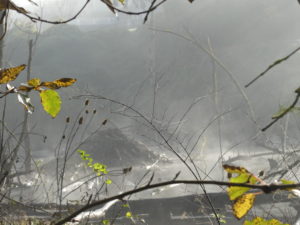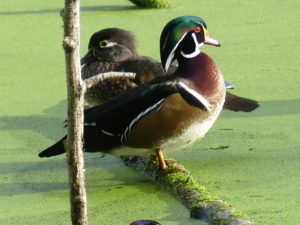Date of volunteer work: 01/01/2021.
Site Name: Erroll Heights.
Number of hours worked: 2.
Field notes:
Beginning a new year at Erroll Heights wetlands. in 2020 I visited every week for 1-2 hours, except for the parks closure period. The area continues to change, mostly driven by beaver activity. As more area becomes flooded, more trees rot and fall down, while others are simply chewed down and removed for food and dam material. There is less and less leafy cover over the ponds, and as they are shallow, they heat and are filled with duckweed and algae all summer. There are now a series of six dams, and a few smaller impoundments, the last one being the bed of SE 45th street itself. Many beaver live here, and are assisted in their activities by even more nutria.
As the lower part of the park is mostly wet year round, there has been little impact from homeless campers. There have been some on the upper plateau of the park, and are some on the BES property to the west, but the natural area has seen little effect. Litter accrues along the path but is easily picked up, and there has not been regular illegal dumping.
Bird life was a little more diverse , with widgeons, mergansers, and buffleheads added to the usual wood ducks, mallards, herons and Canada geese. With more dead trees, there have also been more woodpeckers as well.
My National Phenology Network data showed earlier bud break and flowering for several shrub species this year, compared to previous ones. This is my third year participating in Natures Notebook, collecting species data for the national phenology program that tracks trends across the country. Each week I enter data for eight species, noting the status of leaves, flowers and fruits. I may need to choose a couple of new specimens, as one was crushed by a falling tree and another was sprayed with herbicide.
Invasive removal was not as much of an issue this year, perhaps because of the work by BES crews and others pulling nightshade and spraying thistle and teasel. I did do a lot of deadheading female thistle flowers and flag iris. I also cut down a lot of clematis, still a problem though there has been a lot of effort to remove it. I marked several spots to check next spring for earlier intervention.
All in all a good year in the park. The beaver continue their clandestine activity, expanding their domain. During the early part of Covid closures, there were many more park visitors, mostly families. Trail use continues at a higher rate that before Covid, thought is subsided at the end of the year. I’m happy many more people have found the park.. There has been some dog walkers and bike use of the trail, but almost all of the dogs on leash. Looking forward to 2021. Now that the blog is back up, I hope to make more entries.


